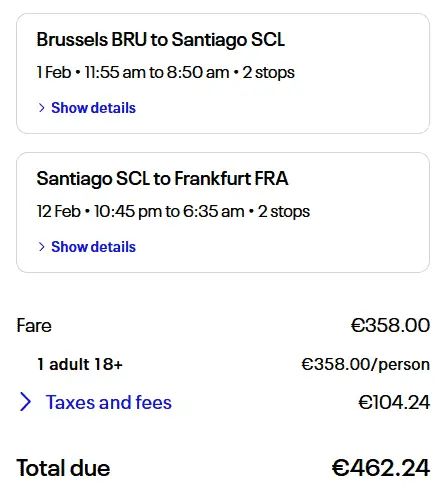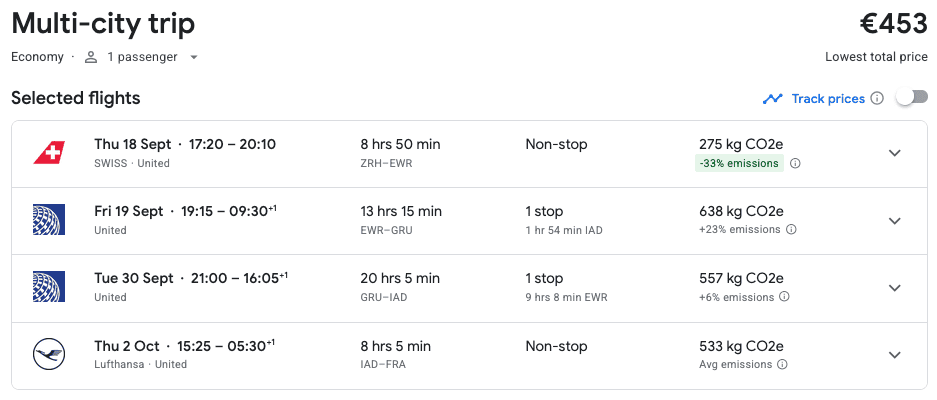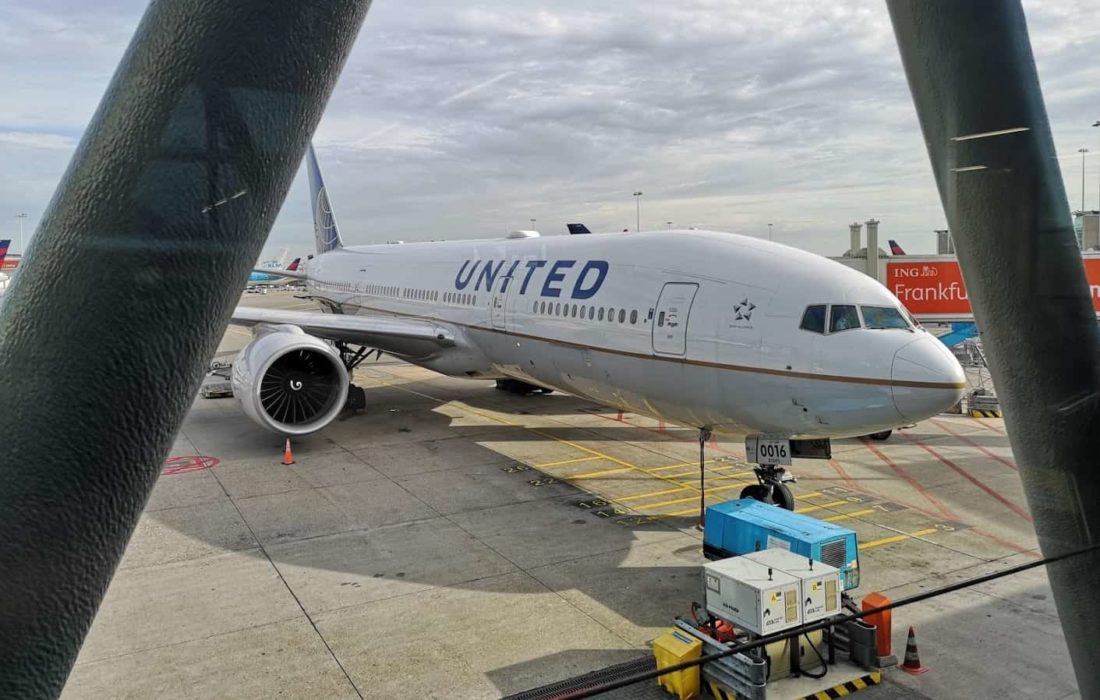Before the pandemic, they were a regular occurrence: Reduced open-jaw flights to South America with United Airlines. Back then, they were particularly interesting as mileage runs. Thanks to the detour through North America, it only took three such trips for MileagePlus Gold status, or five for Premier 1K.
Now, the cheap tickets have returned. Unfortunately, they are no longer attractive as mileage runs since MileagePlus switched to revenue-based status points. However, anyone who wants to travel to South America cheaply and isn’t deterred by the long flight time should jump on this deal. Numerous combinations to destinations like Chile, Brazil, or Argentina can be booked from €437. You need to change planes – and therefore immigrate – to the USA if you want to take advantage of this deal.
Checked baggage (at least 23 kg, on most routes 2×23 kg) and seat selection are included.
The departure airport and the final airport of the trip must be in different countries. Here are some examples:
- Zurich – São Paulo – Frankfurt at €449
- Zurich – Santiago de Chile – Amsterdam at €461
- Brussels – Santiago de Chile – Frankfurt at €463
- Brussels – São Paulo – Berlin at €471
- Zurich – São Paulo – Frankfurt at €498
- Brussels – São Paulo – Frankfurt at €500
- Zurich – Buenos Aires – Berlin at €505
- Brussels – Buenos Aires – Frankfurt at €506
- Zurich – Bogotá – Munich at €514
- Berlin – Lima – Brussels at €531
Double open-jaw flights are also possible, and sometimes even a bit cheaper:
- Milan – Buenos Aires | São Paulo – Munich for €437
- Madrid – Quito | São Paulo – Paris for €441
- Zurich – Santiago de Chile | São Paulo – Munich for €449
- Geneva – Buenos Aires | Santiago de Chile – Frankfurt for €459
The best way to search is via Google Flights. Direct entry via the United website does not show all options, making it more expensive in many cases. You can also try our form below, but you will likely need to play around with the dates to find something cheap. We found availability primarily for September to November 2025 and January to April 2026:

The flights typically include one or two layovers each way. Due to the detour via the USA, the total travel time is very long, at about 25 – 30 hours per direction. The options with two layovers are often slightly cheaper and even a bit faster on the return trip. However, those who can sleep on a plane might prefer a 10 to 16-hour layover in, for example, Chicago, over another domestic flight.
By default, connections with United are primarily shown. However, if you break down the outbound or return flight into multiple segments in the search, you can also find connections with Lufthansa or Swiss.
Most Europeans need an electronic system for travel authorization (ESTA) to enter the USA for up to 90 days. This costs US$40 (~€34) and you should apply for it a couple of days before your trip, at the latest.
There are some cases where you cannot apply for an ESTA, e.g. if you’ve been to Cuba since 2021 or to Iran, Iraq, Syria, Sudan, or North Korea since March 2011. In those cases, you’ll need to get a visa from a US embassy or consulate, which can take multiple weeks.
Search & Book
According to the fare rules, the following travel periods are permitted:
- September 1 to December 9, 2025
- January 21 to May 14, 2026
The minimum stay is one night from Saturday to Sunday, and a maximum stay of 12 months is possible.
We recommend to use Google Flights to find available flight dates. You often have to play around with the departure airports or travel dates to find a cheap connection. Afterwards, Google can redirect you to book directly with United.
Unfortunately, stopovers cost a hefty €300 surcharge. However, if you’re up for a whirlwind tour of the USA, you could at least take advantage of a mini-stopover (< 24h) in, for example, New York or Washington. This is not a bad idea, especially on the return journey, as you would otherwise have to endure two consecutive night flights:

Miles & Points
The tickets are issued in booking class K. For the example route BRU - IAD - IAH - SCL - IAH - ORD - BRU, you can expect the following mileage credits:
- 9,737 Miles on Asiana Club
- 9,737 Miles on Turkish Airlines Miles&Smiles
- 9,737 Award Miles + 1,947 Tier Miles on Azul TodoAzul
- 9,737 Miles on Copa ConnectMiles
- 9,737 Miles on Ethiopian ShebaMiles
- 9,737 Miles on EVA Infinity MileageLands
- 9,737 Miles on Thai Royal Orchid Plus
- 9,737 Award Miles + 4,869 Tier Miles on Avianca LifeMiles
- 9,737 Miles on Aegean Miles+Bonus
- 9,737 Miles on Egyptair Plus
- 7,834 Miles on Air China PhoenixMiles
- 5,842 Miles on ANA Mileage Club
- 4,887 Award Miles + 280 Points on Miles&More
- 4,869 Miles on Singapore KrisFlyer
- 4,869 Miles on TAP Miles&Go
- 4,869 Miles on Air Canada Aeroplan
- 4,869 Avios on Aer Lingus AerClub
- 4,869 Award Miles on Emirates Skywards
- 4,869 Points + 9,737 SQC on Air Canada Aeroplan 2026
- 1,942 Award Miles + 388 PQP on United MileagePlus
- 1,942 Points + 38 Tiles on JetBlue TrueBlue
- Customize Calculation
With an existing frequent flyer status, it might become even more attractive, e.g., the Executive Bonus at Miles&More doubles the credited miles. The following calculator takes this into account:
Destination
Information & Tips for Argentina
Argentina offers a wide range of travel experiences, from the dramatic peaks of Patagonia and the glaciers of El Calafate to the thundering Iguazú Falls in the subtropical north and the vibrant streets of Buenos Aires. The local currency is the Argentine peso (ARS), though U.S. dollars are sometimes accepted in tourist areas. Prices can vary widely—Buenos Aires tends to be more affordable than many Western cities, though inflation and exchange rate fluctuations can impact costs. Weather varies by region: the north is hot and humid, the south cool and windy, and the capital has mild winters and warm summers.
Getting around Argentina can be mixed: within major cities like Buenos Aires, public transport is extensive and cheap, with buses, trains, and a subway system, though they can be crowded and delays are common. Taxis and rideshare apps like Uber are widely available. Traveling between cities often requires long-distance buses, which are reliable but slow, or domestic flights, which are faster but can be pricey and sometimes delayed. Train service between cities is limited.
→ All Dealz for Argentina
Information & Tips for Brazil
Brazil is famous for attractions like the Amazon rainforest, the vibrant cities of Rio de Janeiro and São Paulo, and natural landmarks like Iguazu Falls and Pantanal. The currency is the Brazilian real (BRL), and credit cards are commonly accepted in most places. The price level can vary—major cities and tourist spots can be expensive, but other areas offer more affordable options. Brazil’s weather is tropical, with hot, humid summers, especially in coastal regions, while southern areas experience milder winters. The best time to visit is generally during the dry season, from May to October.
Brazil’s transport infrastructure varies across the country. In major cities like Rio de Janeiro and São Paulo, public transport includes buses, metros, and taxis, though traffic congestion can make getting around slow at times. Ride-hailing apps are widely used and convenient. For intercity travel, long-distance buses are a common, affordable option, but they can be slow. Domestic flights are popular for longer distances, offering quick access to destinations like the Amazon or coastal areas. However, outside major cities, transportation options may be less frequent or reliable, requiring more planning.
We’ve compared various eSIM providers, such as Airalo and Maya Mobile. To see which plan is best for your travel needs, and which network offers the best coverage, feel free to read our detailed guide:
The Best eSIM Plans for Brazil 🇧🇷 Compared
→ All Dealz for Brazil
Information & Tips for Chile
Chile offers diverse landscapes, from the arid Atacama Desert in the north to glaciers and mountains in Patagonia in the south, with popular spots like Santiago, Valparaíso, and Torres del Paine National Park. The currency is the Chilean peso (CLP), and credit cards are widely accepted in urban areas. Prices are moderate—more expensive than some Latin American countries but generally cheaper than Western Europe. Weather varies sharply by region: the north is dry and hot, the central region has a Mediterranean climate, and the south is cool and rainy, especially in winter.
Chile’s transport infrastructure is generally functional, though not always convenient. In cities like Santiago, public transport is fairly efficient, with a modern metro and bus network, but traffic congestion is common. Smaller cities have fewer options and often rely on colectivos (shared taxis) or buses. For intercity travel, long-distance buses are the main option and are generally comfortable and punctual. Domestic flights are useful for covering the country’s long north-south distance, especially when heading to remote areas like Patagonia or the Atacama Desert.
→ All Dealz for Chile
Information & Tips for Colombia
Colombia has a mix of attractions, from colonial towns like Cartagena and mountain cities like Bogotá and Medellín to natural spots like Tayrona National Park and the Coffee Region. The local currency is the Colombian peso (COP), and while cards are accepted in most cities, cash is often needed in smaller towns. Prices are generally low, especially for food and transport, though tourist hotspots can be more expensive. Weather depends heavily on altitude—coastal areas are hot and humid year-round, while cities in the Andes tend to be spring-like, with mild days and cool nights.
Transport in Colombia varies by region. Within cities, options include buses, taxis, and rideshare apps, though traffic can be heavy, especially in Bogotá. Medellín stands out with its clean and efficient metro system. Intercity travel is mostly by bus, which can be slow due to mountainous terrain, but services are frequent and affordable. Domestic flights are common and often necessary for longer distances, given the country’s geography and limited rail infrastructure.
→ All Dealz for Colombia
Information & Tips for Peru
Peru is best known for Machu Picchu and the Sacred Valley, but also draws visitors to Cusco, Lake Titicaca, the Amazon, and coastal Lima. The local currency is the Peruvian sol (PEN), and while cards are accepted in cities, cash is often needed in rural areas. Prices are moderate—cheaper than many Western countries but higher in tourist zones. Weather varies: the coast is dry and mild, the Andes have cool temperatures and a distinct rainy season (Nov–Mar), and the Amazon is hot, humid, and rainy most of the year.
Peru’s transport infrastructure is basic but workable. In cities like Lima, public buses and informal minibuses are common but can be chaotic and confusing for visitors. Taxis and rideshare apps are widely used, though traffic congestion is a regular issue. Between cities, long-distance buses are the main option—generally affordable and comfortable, but travel times can be long due to mountainous roads. Domestic flights are often the fastest way to reach places like Cusco or the Amazon, as train routes are limited and mostly serve tourist areas.
→ All Dealz for Peru

Comment (1)
Perfect itinerary for upgrading to MM Silver! If you max it out, you can get (20+60+20+60)*2=320 Points and (20+60)*2=160 Q Points (could be more if you add more segments if available). That is almost half of 650 P/325 QP!